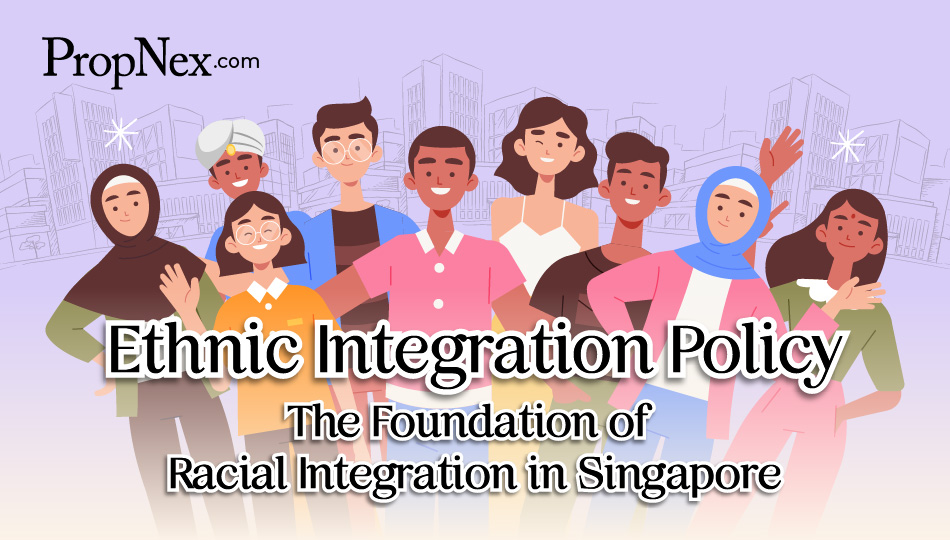Ethnic Integration Policy (EIP): The Foundation of Racial Integration in Singapore


The United States is often referred to as a "melting pot", a nation that welcomes immigrants from all over the world who want to chase the American dream. Yet, despite this, the headlines we read paint a different picture. Racial tension within the US continues to simmer, with minority communities - Black, Jewish, Hispanic, Asian, you name it-facing prejudice and discrimination.
Meanwhile, racial integration in Singapore is not a mere idea, but a reality, thanks to the Ethnic Integration Policy (EIP). This policy has fostered a sense of harmony not seen anywhere else. Just think about when you step out of your flat every morning, are you greeted by "morning", "zao an", "ho-seh bo", "pagi", "sup" or perhaps all these?
Introduced in 1989, the EIP was designed to counteract the formation of ethnic enclaves in Singapore's public housing. Before that, it was common for certain neighbourhoods to be predominantly populated by one ethnic group, which could lead to segregation. Several racial riots even broke out in the 1960s, leaving plenty dead and injured.
Thus, an ethnic quota is implemented in HDB estates to mandate a balanced mix of people, especially between the three main groups that make up most of Singapore's population: Chinese, Malay and Indian. As such, the EIP forces residents of different races to live together and interact with one another on a regular basis. Though it almost seems dictatorial at first, over time, these interactions build mutual understanding and respect, breaking down prejudices and fostering a community that not only tolerates diversity but also embraces it.
Along with this intermingling, the emergence of interracial marriages and mixed-race families rises. This, in itself, is a testament to the success of EIP. However, it poses a challenge in the housing market. Those who are of mixed race can only pick one ethnic category when buying or renting in public housing because it directly correlates to the quota. For instance, a Chinese-Malay can choose to be regarded as Chinese or Malay in their housing application.
Despite offering people the flexibility to choose their own racial classification, the EIP still has much room for improvements. How will this policy hold up as the next generation of multiracial children becomes old enough to buy or rent public housing? Perhaps a change in the system is needed to better accommodate these increasingly diverse families.
Moreover, if a particular ethnic group quota for a neighbourhood is already met, then owners can only sell to people from other ethnic groups. As a consequence, they might end up having to sell their flats at a lower price. For example, when the Malay quota of the block is filled, a household can only sell their flat to non-Malay(s). This means the unit is only open to a smaller pool of buyers, and we all know that lower demand equates to lower prices. Likewise, buyers from that group may have fewer flat options and would need to increase their budget to find a home.
Recently, Mr Shaik Amar, a property agent, shared a video online stating that the EIP offers no benefit to ethnic minority households and instead disadvantages them when they sell their flats. He also stated that the EIP has not been updated since it was introduced in the 1960s.
The Ministry of National Development (MND) had to come out with a statement to address this case, reminding everyone that the EIP benefits minorities in various ways. They also pointed out that Mr. Shaik himself had benefited from the EIP, allowing his household to get a Sale of Balance Flat (SBF). The MND also underlined that the EIP was introduced in 1989, and has continued to evolve to meet society's changing needs. For instance, in 2022, HDB came out with an EIP buyback assistance scheme to provide a fallback option for homeowners to sell their flats to HDB at a fair price based on market conditions.
The agent ended up being issued a Protection from Online Falsehoods and Manipulation Act (POFMA) order for his false claims. He has since taken down his video from TikTok and Instagram but has yet to do so on YouTube.
This case is proof that the EIP is still often misunderstood. While the EIP does impose certain restrictions on the sale of HDB flats to ensure a balanced ethnic mix, the policy is not designed to disadvantage any particular group. Rather, it aims to promote social cohesion by preventing ethnic enclaves and encouraging interaction among different communities. The government has also introduced various support measures like housing schemes and grants to further help homeowners and ensure that the market remains fair and effective.
In any case, the EIP can only be so successful because a majority of Singaporeans live in public housing. This means that the policy reaches a significant portion of the population, allowing ethnic integration to occur on a large scale. So, it's only natural that the integration extends beyond public housing - to workplaces and more importantly, schools.
Letting children study and play with peers from different backgrounds will only further break down racial barriers and create a sense of friendship among them. Learning to appreciate and celebrate each other's cultures, traditions and perspectives from a very young age is the key to continuing the EIP's legacy. Schools in Singapore even celebrate Racial Harmony Day, where students can put on traditional costumes and engage in cultural activities.
Source: The Frontier Primary School
The success of the EIP is also backed by Singaporean's firm government policies. As they are able to enforce regulations consistently and effectively, EIP's goals are systematically pursued and achieved. This is also why this kind of policy might not work in other countries, especially those whose governments are lenient, biased or even corrupt.
In Malaysia, for example, the New Economic Policy (NEP) was introduced to improve the economic position of the Bumiputera population. However, the NEP has faced criticism regarding its inefficiency, corruption, and lack of transparency. Funds intended for the initiative were also susceptible to misuse and mismanagement.
On the other hand, Canada's multiculturalism act, though emphasises the importance of cultural diversity, has less government intervention in housing. While this approach isn't quite as controversial as the NEP, it's not always successful in breaking down ethnic barriers.
In comparison, Singapore's EIP reigns supreme. The combination of government regulation and grassroots community building has resulted in a balanced ethnic mix in public housing estates. Studies have even shown that residents in HDB estates tend to have more diverse interactions compared to those in private housing.
All things considered, the EIP remains relevant today as racial harmony requires continuous effort. As Singapore grows and evolves, the EIP will need to be adjusted and refined to tackle new challenges. There may be a need to revisit ethnic quotas depending on the evolving demographic and even the redefinition of existing categories. That said, we must admit that the EIP plays an important role in Singapore's ongoing journey towards a harmonious society, and other countries should definitely take note!
Views expressed in this article belong to the writer(s) and do not reflect PropNex's position. No part of this content may be reproduced, distributed, transmitted, displayed, published, or broadcast in any form or by any means without the prior written consent of PropNex.
For permission to use, reproduce, or distribute any content, please contact the Corporate Communications department. PropNex reserves the right to modify or update this disclaimer at any time without prior notice.












